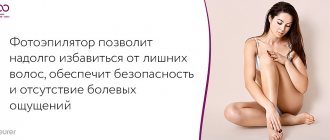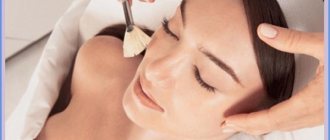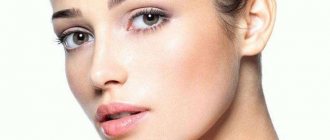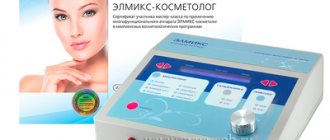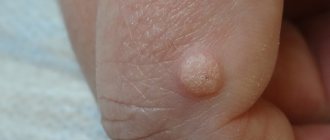There are many ways to lose unnecessary hair on the body, one of which is home photoepilation.
We will talk about the principle of operation of the method, the longevity of the effect and the possibility of application on various areas of the skin.
To properly carry out the hair removal procedure, carefully study the information provided.
Operating principle
Let's start with what this method is and what the effect of photoepilation depends on.
If you have heard about the principle of laser hair removal, then it will be difficult for you to distinguish it from photoepilation, since in both methods the removal of unwanted vegetation is carried out using light waves.
That is, a ray of light hitting the hair causes it to separate from the hair follicle and fall out. The laser also kills the hair follicle, so subsequent hair growth is not observed. Did you know ?
Hair is exposed to laser only at a certain moment of growth, namely: when the hair is 1-2 mm long and connected to the hair follicle, and not just to the walls of the follicle. However, there are many differences that are difficult to explain without going into detail about the entire action.
The first difference is a photoepilation device that emits light with a spectrum from 560 to 1200 nm. This means that several lasers are involved in the work at once. They are capable of removing hair of any color (except gray) from skin of any color.
The second difference is the quality of the procedure. A photoepilator is not able to remove all suitable hairs on the treated area at once. This is due to the operating principle of the laser system itself. Therefore, the number of necessary procedures for complete removal of vegetation almost doubles compared to laser hair removal.
The third difference also applies to photoepilation equipment. Due to the use of a large number of light-emitting elements, the range of action of the epilator increases. That is, the device covers most of the skin at one time, but this is also a disadvantage, which is described in the second paragraph.
The fourth difference (and the main advantage of photoepilation) is the time of the session. Since the work involves many elements that emit light, the duration of the procedure is reduced by 2-3 times compared to laser hair removal.
And the last difference is the price. On average, the price for this procedure is 1.5 times higher than for conventional laser hair removal.
In Europe during the Middle Ages, excess hair on the body was shaved off, and soft hair was rolled out with bread-wax balls.
Difference from other hair removal methods
Photoepilation is not the only way to combat unwanted hair. Its main competitors are laser and electrolysis. What is the difference between them?
Photoepilation or laser
A laser beam and a light pulse are almost equal in their effectiveness on the hair follicle. However, laser use causes redness and swelling of the skin. In addition, burns and bruises may occur. During the “laser” session, the client experiences pain, so before starting the procedure, the specialist applies an anesthetic to the skin.
Electrolysis against light pulse
Photoepilation is not able to eliminate some types of hairs (gray hair and vellus hair). In this case, electrolysis is considered unsurpassed, during which each hair is removed separately. However, it should be understood that such a procedure is quite lengthy, painful and expensive. Using electrolysis it is impossible to treat large areas; this method is used only for small areas (for example, face, bikini).
Pros and cons of the method
According to Karina Lebedeva, dermatologist-cosmetologist at the NUANCE clinic in St. Petersburg, photoepilation has a number of advantages over other methods of hair removal:
- Firstly, the light flash affects the entire color spectrum of hair (with the exception of gray hairs).
- Secondly, this is a fairly painless method.
- Thirdly, photoepilation is a non-invasive method, therefore the risk of infection is reduced to zero.
- It is also important that after the procedure there are no burns left on the skin.
Physiotherapist, specialist at the OASIS beauty, SPA and fitness center Olga Kulkova considers the painlessness of the method and a minimal number of contraindications to be a clear advantage of photoepilation.
It should also be added that:
- the procedure can be applied to any part of the body;
- depending on the skin type, hair color and the treated area, you select your own mode for delivering light pulses, which ensures the most effective hair removal without causing undesirable consequences;
- the effect of photoepilation can last from 6 months to several years;
- The maximum time for the procedure is 20 minutes.
However, photoepilation also has its disadvantages, which the client needs to know about before starting the procedure:
- this method is ineffective for light-colored hair;
- gray hair cannot be removed with its help;
- it is impossible to get rid of all hairs in one session;
- in some cases, exposure to a light beam can cause peeling of the skin;
- an incorrectly chosen regimen provokes side effects.
Video: specialists about photoepilation
How to choose the right photoepilator
Let's talk about choosing a device for photoepilation at home. Due to the fact that this procedure in clinics is quite expensive, and the number of procedures involves significant waste, choosing a “home” photoepilator is not only saving money, but also timely getting rid of hair.
Popular brands and approximate prices
When choosing a device for home photoepilation, first of all you need to pay attention to the list of manufacturers, maximum and minimum prices.
Major manufacturers of equipment for home use:
- "Babyliss";
- "Beurer"
- "Braun";
- "Panasonic";
- Philips;
- Remington;
- “Rio Beauty;
- Rowenta;
- "Silk'n"
Of these, two manufacturers can be distinguished that have the largest assortment - BaByliss and Philips.
The price range for hair removal devices is quite wide, so you can choose either the most economical option, which costs $27-30, or the most expensive, which costs $670-700.
Depending on the price, a device for home photoepilation can be portable or powered from the mains, equipped with a cooling system or additional lighting.
Advice !
Portable photoepilators capture a smaller area of skin and discharge quickly enough, so it is not recommended to buy a battery-powered unit unless there is a proper need. The kit may also include attachments for sensitive skin, removal of individual hairs, or for facial hair removal.
The effectiveness of home appliances on different parts of the body
The effectiveness of photoepilation at home is the main question that interests many girls reading this article.
The fact is that, as in the case of laser hair removal, it is worth considering many factors that affect the effectiveness of the procedure. It all depends not only on the high cost of the device, but also on the settings. You need to choose exactly the radiation interval and the power at which the hairs and hair follicles will be destroyed, and the skin will not be burned.
However, do not be afraid, since device manufacturers have foreseen the possible consequences and made the maximum power of photoepilators such that you cannot cause significant damage to yourself.
Therefore, after reading the instructions in detail, you will be able to compare your hair type with those offered in the catalog and set the settings correctly.
Now let's talk about certain parts of the body on which vegetation most often causes inconvenience.
Advice !
When removing hair from sensitive areas (bikini and face), use special attachments to ensure proper operation of the device. Bikini zones. The effectiveness of photoepilation in the bikini area is quite high, since in this area the skin is naturally very light, and the hairs themselves are quite dark, so the device works very well, removing unnecessary hair. The only thing worth focusing on is the duration of the session.
Since the skin in the bikini area is very thin, prolonged exposure to the laser can lead to burns, so carefully read the instructions for the photoepilator and do not exceed the described time limits.
Deep bikini areas. A deep bikini includes the pubic area and labia minora.
The only difference between deep bikini photoepilation and regular bikini is the number of light flashes required to achieve maximum effect. So, to remove hair from the contour of underwear, 6-30 pulses are enough, and to remove hair from the pubis and labia, you need from 30 to 90 flashes. Advice !
To achieve maximum effect when preparing for a summer trip to the sea, you need to start procedures at the end of winter. On the face. Excessive facial hair is a girl’s worst nightmare, since, unlike other parts of the body, you cannot cover your face with anything, and the maximum effect is expected from the procedure.
The photoepilator perfectly removes hair from the face, but the hair must be 1-2 mm long and not bleached. If these conditions are met, then you only need to carry out a 7-10 minute procedure to begin getting rid of hair.
It is worth remembering that photoepilation will be useless in areas with bleached hair, since they are not exposed to laser irradiation. That is why be careful and do not exceed the time limit for removing such vegetation, otherwise you will either overheat the device or damage the skin.
Consumer Reviews
Those who have already experienced the delights of photoepilation note the quick and lasting effect, for which it is worth enduring the pain.
Feelings: of course, the procedure is not pleasant, there is a burning sensation from photo flashes, but these are short-term flashes, there is time to rest. At the same time, the armpit area is quite tolerable, over time it even stopped reacting, the bikini area - there are very sensitive places when it actually shuddered, but I think that all this is tolerable, fast and the result is worth it. After the first session, a few days later the hairs began to fall out in clumps (I was told not to shave so that the result could be seen) and grow extremely slowly. At first I went for photoepilation once every one to one and a half months, then less and less, my hair practically stopped growing. For me it was simply magical: the irritation went away, the skin brightened in the areas where I shaved, and the unpleasant darkening that I was embarrassed about disappeared. Armpits and bikini became smooth. Overall, I couldn't stop looking at it. And I couldn’t be happier, because compared to how I used to have to shave once every three days and feel a constant burning sensation from irritation - for me it was just a thrill.
Valencia
https://otzovik.com/review_3028431.html
Experienced clients of beauty salons recognize the highest effectiveness of this method of combating unwanted hair.
I have done all types of hair removal and I can assure you that photoepilation is the most effective hair removal procedure!!! Smooth skin of bikini and legs without stubble and ingrown hairs, I guarantee!!! No razor, only a combination of photoepilation + wax gives an amazing result.
Consumer inessa012 shows off smooth skin after treatment
inessa012
https://irecommend.ru/content/fotoepilyatsiya-luchshe-eshche-ne-pridumali
However, this procedure is not successful for everyone.
It's been two years since I had this procedure. My cosmetologist recommended it to me. I went to a good clinic. I hadn’t read reviews on the Internet before, so I trusted the professionals. In general, it was painful, in response to my request to do less, she said: “There is no room for less, I do my face at less power.” We had a procedure for photoepilation of all legs. It was very painful, everything turned red, the pain did not stop for about a month, the marks turned into sores and became crusty. Then the scabs fell off and in some places there were scars, but mostly just pigment stripes. And now two years have passed, and I’m still like a striped tiger. Pants in winter, long skirts in summer, I can’t swim or sunbathe. I spent a lot of money on different whitening products. Of course, now everything is much paler than it was, but there are spots all over my legs. Before you decide to do the procedure, carefully read the reviews, listen to the advice and try one flash on your skin first. Everything is individual.
Mirella_Vinc
https://irecommend.ru/content/bolshie-oslozhneniya-ozhogi-pigentatsiya
To avoid such troubles, before visiting a cosmetologist, you should carefully read the reviews about the clinic and contraindications to the procedure.
Preparation
We will tell you directly about how to do photoepilation at home, and what preparation needs to be done before performing the procedure.
Before hair removal, you need to visit a dermatologist so that he can determine your skin type and decide whether photoepilation can be carried out at the moment or not.
If the doctor gives a positive answer, we move on to the second stage, which involves reducing the hair length to 1-2 mm. To do this, we only use a razor; no other methods of removing vegetation are suitable. In order not to sit with a ruler, measuring the desired length, simply shave the desired part of the skin 1-2 days before the procedure.
After studying and charging the device, we cleanse the skin using a scrub or other products that do not contain abrasive particles (they have increased hardness). Before epilation, the skin must be clean and completely dry. This completes the preparation for photoepilation.
How to do the procedure at home: features of the procedure
Let's look at how to properly do photoepilation at home in step-by-step instructions.
After the preparatory stage, turn on the device and bring it to the skin. The sensors must determine whether the settings are correct for your skin and hair type. If everything is normal, the indicator will light green or blue; if not, it will light red. When removing hair, the epilator must be moved horizontally or at an angle of 45° to achieve maximum effect.
When carrying out the procedure on sensitive areas, you should apply a special photoepilation gel, which diffuses light and reduces pain.
When the allotted time for the treated area is over, the photoepilator will emit a sound signal, after which you need to move the device to another part of the skin or end the procedure.
On average, in 50 pulses the epilator covers an area of 2.5 cm, which is worth considering when moving after a signal.
About the photoepilation procedure, how to do it at home and devices for this type of hair removal, watch this video:
It is worth remembering that for safety reasons you must wear protective glasses for photoepilation, otherwise you can seriously damage your eyesight.
Important !
Epilate away from reflective surfaces (mirror, glass, metal) so that the light beam cannot reach your face, head or eyes. Constantly monitor your sensations during the procedure. You should not feel severe pain or the absence of any irritants at all. In the first case, the beam is too strong, in the second, it is weak. A slight burning sensation, discomfort, sensation of rupture of the follicles in the skin - this is what you should feel during hair removal.
Post-procedure care
After the procedure, it is recommended to apply a special cream that will soothe the skin and moisturize it. Next, use sunscreen (if your skin is not covered by clothing) for two weeks.
During the day after photoepilation, you should not take a cold or too hot shower, wear tight-fitting clothes that come into contact with the treated area, or use chemicals.
From the first to the last procedure (until the entire course is completed), you cannot go to the solarium, sunbathe on the beach, or remove hair in any other way (except with a razor).
If, after photoepilation, severe redness of the skin or burning sensation is observed, then Panthenol or other preparations for burns should be used.
Important !
Any cosmetics that are applied to the skin area during the entire course should not contain alcohol. It is worth adding that after photoepilation at home, you need to clean the device used of fat, cooling gel or hair. Pay attention to the life of the lamps used to produce the light beam. They have a short service life and require frequent replacement.
Adverse reactions
Undesirable consequences do not occur often. The cause is usually errors in setting up the device, hypersensitivity of the skin, or non-compliance with the rules of the procedure.
The following side effects are possible:
- burns and skin irritation;
- the appearance of an inflammatory rash;
- scarring of damaged skin areas;
- dysfunction of the sweat glands;
- formation of age spots;
- folliculitis.
There may be slight redness of the treated areas and dry skin. These phenomena usually go away on their own within a week. To speed up regeneration, use moisturizing and healing products on a non-greasy basis.
Exposure to light waves of insufficient length can provoke the opposite effect in the form of excessive hair growth in the area. In order to prevent the development of complications, you need to choose a competent specialist and properly prepare for hair photoepilation.
How many sessions will it take?
The average number of sessions required to obtain a stable effect is 5-6. However, the procedures must be carried out strictly after a certain period of time, so that at the time of removal the hair is at the desired stage of growth.
Therefore, answering the question of how often photoepilation should be done during one course, it is worth citing statistical data: the procedure must be repeated every 3-4 weeks in order to destroy those 30% of hair that are ready for removal.
It is worth remembering that a second course of hair removal will need to be carried out after 7-8 months, otherwise the hair will gradually return.
Photoepilation was invented by Morgan Gusgavsson. In 1990, at a congress of dermatologists in Stockholm, a Swedish doctor and engineer told the world about his discovery - the possibility of using intense pulsating light technology in cosmetology.
Contraindications
Contraindications to photoepilation are similar to contraindications to laser hair removal.
Here is the most complete list of contraindications:
- age under 18 years (due to hormonal levels);
- diabetes;
- diseases of the cardiovascular system;
- phlebeurysm;
- herpes, dermatitis and other skin diseases;
- skin damage (abrasions, scratches, wounds, burns);
- the presence of a large number of moles and birthmarks in the treatment area;
- pregnancy;
- period after prolonged exposure to the sun or solarium;
- while taking steroids;
- porphyrin disease or allergy to sunlight.
All these contraindications must be observed, otherwise you will harm your health or not get the expected effect.
It is worth noting that the age limit is not associated with a threat to health, but with the futility of use, since during puberty, hair growth and the appearance of new hair follicles accelerate.
Benefits of photoepilation
Photoepilation of hair outperforms alternative methods of depilation and epilation on a number of points.
The advantages of light hair removal are:
- Efficiency. The result of the treatment is visible after the first procedure and lasts for a long time. Hair growth in the area of the device stops.
- Painless. According to people's reviews, the photoepilation procedure does not cause significant discomfort.
- Versatility. The method is suitable for treating different areas of the body, including the facial area and areas of increased sensitivity (bikini, armpit area).
- Performance. Photoepilators are capable of treating large areas in a short time. The duration of the session is from 5 minutes to half an hour. The flash can cover a surface area of up to 5 square meters. cm.
- Safety. After properly performed hair removal, there are no signs of skin irritation (redness, itching, excessive dryness). The appearance of ingrown hairs is excluded.
Flashes of light stimulate the formation of collagen in the dermis, which means they have a rejuvenating effect and improve skin turgor.

